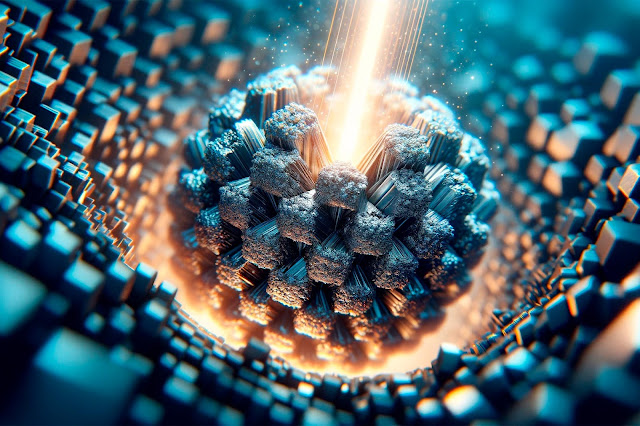X-ray absorption spectroscopy is a commonly used analytical technique for studying the composition of materials or substances. It is selective for certain elements and sensitive to changes in the electronic state. Until recently, the technique did not offer ultrafast temporal resolution to study electronic dynamics and needed laborious wavelength scanning.
Under the direction of ICREA Prof. at ICFO Jens Biegert h, the Attoscience and Ultrafast Optics group at ICFO has developed attosecond soft-X-ray absorption spectroscopy over the past ten years into a new analytical tool that has attosecond temporal resolution and does not require scanning.[1,2]
Breakthrough in Attosecond Soft-X-ray Spectroscopy
Attosecond soft-X-ray pulses may simultaneously probe a material’s whole electronic structure, with a duration of 23 as to 165 as and a concurrent coherent soft-X-ray bandwidth of 120 to 600 eV[3].
A completely new and potent instrument for solid-state physics and chemistry is made possible by the combination of coherent bandwidth that registers the change and time resolution that allows real-time electronic motion detection.
The interaction of light with matter is one of the most fundamentally significant processes; for example, it helps to understand how solar energy is captured by plants or how a solar cell turns sunlight into electricity.
The possibility of using light to change a material or substance’s quantum state or function is a fundamental component of material science. Investigating the many-body dynamics of materials helps solve fundamental questions in modern physics, such as what initiates a quantum phase change or how microscopic interactions give rise to a material’s features.
Recent Study by ICFO Researchers
Researchers from ICFO Themis Sidiropoulos, Nicola Di Palo, Adam Summers, Stefano Severino, Maurizio Reduzzi, and Jens Biegert report that they have observed a light-induced increase and control of the conductivity in graphite by adjusting the material’s many-body state. Their findings were published in the journal Nature Communications.
Innovative Measurement Techniques
The light-matter hybrid state was induced by the researchers using carrier-envelope-phase-stable sub-2-cycle laser pulses at 1850 nm. At the graphite carbon K-edge at 285 eV, they used attosecond soft x-ray pulses with a duration of 165 to investigate the electrical dynamics. The complete electronic structure of the material was examined at attosecond-interval pump-probe delay stages using the attosecond soft-X-ray absorption measurement. The material is referred to as a light-matter hybrid because the pump at 1850 nm created a high conductivity state in it that is only possible because of the light-matter interaction.
Because these conditions are predicted to produce quantum features in materials that would not otherwise exist in equilibrium and because these quantum states can be swapped at almost optical rates up to many THz, researchers are interested in studying them.
However, the precise manifestation of these states within materials remains mostly uncertain. Thus, recent publications on topological phases and light-induced superconductivity are rife with conjecture. For the first time, ICFO researchers were able to “look inside the material” as the light-matter state materialized by using soft-Xray attosecond pulses.
“The requirement for coherent probing, attosecond time resolution, and attosecond synchronization between pump-and probe is entirely novel and an essential requirement for such new investigations enabled by attosecond science,” says Themis Sidiropoulos, the study’s first author.
Electron Dynamics in Graphite
Sidiropoulos explains that “instead of manipulating the sample, we optically excite the material with a powerful light pulse, thus exciting the electrons into high energy states and observe how these relax within the material, not only individually but as a whole system, watching the interaction between these charge carriers and the lattice itself.” This is in contrast to twistronics and twisted bilayer graphene, where experimentalists physically manipulate the samples to observe changes in the electronic properties.
To see how the electrons in the graphite relaxed after the strong pulse of light was applied, they took the broad X-ray spectrum and observed, firstly, how each energy state relaxed individually and, secondly, how the whole electron system was excited, to observe the many-body interaction between light, carriers, and nuclei at different energy levels. Through the system’s observation, scientists were able to discern that the energy levels of each charge carrier demonstrated that the material’s optical conductivity peaked at a certain point, exhibiting remnants or indications of a superconducting phase.
Observation of Coherent Phonons
How could they have seen this? Indeed, they did detect the behavior of coherent (as opposed to random) phonons or collective excitation of the atoms within the solid in a prior article. Through mechanical vibrations of the lattice, graphite’s array of very strong (high energy) phonons may effectively carry large amounts of energy away from the crystal without causing any damage to the material. Furthermore, the solid’s electrons appear to ride the wave created by these coherent phonons as they oscillate back and forth, giving rise to the fake superconductivity signs that the researchers saw.
Implications and Future Prospects
The study’s findings point to possible uses for photonic integrated circuits and optical computing, which include controlling and modifying material properties with light or utilizing light to manipulate electrons. In conclusion, Jens Biegert states that “many-body dynamics are at the core, and perhaps one of the most difficult problems of modern physics.” Our findings here pave the way for future developments in physics that will enable real-time manipulation and study of correlated phases of matter—a critical component of contemporary technology.



